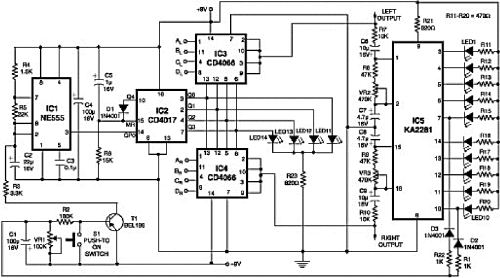Stereo Channel Selector
The add-on circuit presented here is useful for stereo systems. This circuit
has provision for connecting stereo outputs from four different sources/channels
as inputs and only one of them is selected/connected to the output at any one
time.
When power supply is turned СonТ, channel A (AR and AL) is selected. If no audio
is present in channel A, the circuit waits for some time and then selects the
next channel (channel B). This search operation continues until it detects audio
signal in one of the channels. The inter-channel wait or delay time can be
adjusted with the help of preset VR1. If still longer time is needed, one may
replace capacitor C1 with a capacitor of higher value.
Suppose channel A is connected to a tape recorder and channel B is connected to
a radio receiver. If initially channel A is selected, the audio from the tape
recorder will be present at the output. After the tape is played completely, or
if there is sufficient pause between consecutive recordings, the circuit
automatically switches over to the output from the radio receiver. To manually
skip over from one (selected) active channel to another (non-selected) active
channel, simply push the skip switch (S1) momentarily once or more, until the
desired channel input gets selected. The selected channel (A, B, C, or D) is
indicated by the glowing of corresponding LED (LED11, LED12, LED13, or LED14
respectively).
IC CD4066 contains four analogue switches. These switches are connected to four
separate channels. For stereo operation, two similar CD4066 ICs are used as
shown in the circuit. These analogue switches are controlled by IC CD4017
outputs. CD4017 is a 10-bit ring counter IC. Since only one of its outputs is
high at any instant, only one switch will be closed at a time. IC CD4017 is
configured as a 4-bit ring counter by connecting the fifth output Q4 (pin 10) to
the reset pin. Capacitor C5 in conjunction with resistor R6 forms a
power-on-reset circuit for IC2, so that on initial switching СonТ of the power
supply, output Q0 (pin 3) is always СhighТ. The clock signal to CD4017 is
provided by IC1 (NE555) which acts as an astable multivibrator when transistor
T1 is in cut- off state.
IC5 (KA2281) is used here for not only indicating the audio levels of the
selected stereo channel, but also for forward biasing transistor T1. As soon as
a specific threshold audio level is detected in a selected channel, pin 7 and/or
pin 10 of IC5 goes СlowТ. This low level is coupled to the base of transistor
T1, through diode-resistor combination of D2-R1/D3-R22. As a result, transistor
T1 conducts and causes output of IC1 to remain СlowТ (disabled) as long as the
selected channel output exceeds the preset audio threshold level.
Presets VR2 and VR3 have been included for adjustment of individual audio
threshold levels of left and right stereo channels, as desired. Once the
multivibrator action of IC1 is disabled, output of IC2 does not change further.
Hence, searching through the channels continues until it receives an audio
signal exceeding the preset threshold value. The skip switch S1 is used to skip
a channel even if audio is present in the selected channel. The number of
channels can be easily extended up to ten, by using additional 4066 ICs.
Title: Stereo Channel Selector
electronic circuit
Source: www.electronic-circuits-diagrams.com
Published on: 2005-02-01
Reads: 1948
Print version: ![]()
Other electronic circuits and schematics from Audio
-
3 Line Mixer
-
200W audio amplifier
-
Balanced Low Noise Microphone Preamp
-
Amplified Ear
-
Stereo Tone Control
-
Automatic Loudness Control
-
Portable Microphone Preamplifier
-
Infrared Head Phones
-
Portable Mixer
-
18W Audio Amplifier

